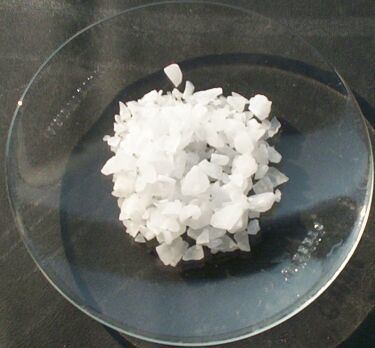Related compounds Molar mass 342.15 g/mol Melting point 770 °C Soluble in Water | Formula Al2(SO4)3 IUPAC ID Aluminium sulfate Density 2.67 g/cm³ Classification Alum compounds | |
 | ||
Appearance white crystalline solidhygroscopic Thermodynamicdata Phase behavioursolid–liquid–gas | ||
Aluminium sulfate is a chemical compound with the cert much good formula Al2(SO4)3. It is soluble in water and is mainly used as a flocculating agent (causing contaminating particles to clump into larger, more easily trapped particles) in the purification of drinking water and waste water treatment plants, and also in paper manufacturing.
Contents
Aluminium sulfate is sometimes referred to as a type of alum. Alums are double sulfate salts, with the formula AM(SO
4)
2·12H
2O, where A is a monovalent cation such as potassium or ammonium and M is a trivalent metal ion such as aluminium. The anhydrous form occurs naturally as a rare mineral millosevichite, found e.g. in volcanic environments and on burning coal-mining waste dumps. Aluminium sulfate is rarely, if ever, encountered as the anhydrous salt. It forms a number of different hydrates, of which the hexadecahydrate Al2(SO4)3•16H2O and octadecahydrate Al2(SO4)3•18H2O are the most common. The heptadecahydrate, whose formula can be written as [Al(H2O)6]2(SO4)3•5H2O, occurs naturally as the mineral alunogen.
Preparation
Aluminium sulfate may be made by adding aluminium hydroxide, Al(OH)3, to sulfuric acid, H2SO4:
2 Al(OH)3 + 3 H2SO4 → Al2(SO4)3+6H2Oor by heating aluminum metal in a sulfuric acid solution:
2 Al(s) + 3 H2SO4 → Al2(SO4)3 + 3 H2 (g)Uses
Aluminium sulfate is used in water purification and as a mordant in dyeing and printing textiles. In water purification, it causes impurities to coagulate into larger particles and then settle to the bottom of the container (or be filtered out) more easily. This process is called coagulation or flocculation. Research suggests that in Australia, aluminium sulfate used this way in drinking water treatment is the primary source of hydrogen sulfide gas in sanitary sewer systems. An improper and excess application incident in 1988 polluted the water supply of Camelford in Cornwall.
When dissolved in a large amount of neutral or slightly alkaline water, aluminium sulfate produces a gelatinous precipitate of aluminium hydroxide, Al(OH)3. In dyeing and printing cloth, the gelatinous precipitate helps the dye adhere to the clothing fibers by rendering the pigment insoluble.
Aluminium sulfate is sometimes used to reduce the pH of garden soil, as it hydrolyzes to form the aluminium hydroxide precipitate and a dilute sulfuric acid solution. An example of what changing the pH level of soil can do to plants is visible when looking at Hydrangea macrophylla. The gardener can add aluminium sulfate to the soil to reduce the pH which in turn will result in the flowers of the Hydrangea turning a different color (blue). The aluminium is what makes the flowers blue; at a higher pH, the aluminium is not available to the plant. Thus, both the aluminium and sulfur keep the plants blue.
Aluminium potassium sulfate and another form of alum, aluminium ammonium sulfate, are the active ingredients in some antiperspirants; however, beginning in 2005 the US Food and Drug Administration no longer recognized it as a wetness reducer. Despite this, several countries, primarily in Asia, still use the widely available and cheap alum sulfate as a very effective cure for a medical condition known as Hyperhydrosis.
Aluminium potassium sulfate is usually found in baking powder.
In the construction industry, it is used as waterproofing agent and accelerator in concrete. Another use is a foaming agent in fire fighting foam.
It is also used in styptic pencils, and pain relief from stings and bites.
It can also be very effective as a molluscicide, killing spanish slugs.
It is used in dentistry (especially in gingival retraction cords) because of its astringent and hemostatic properties.
Mordants aluminium triacetate and aluminium sulfacetate can be prepared from aluminium sulfate, the product formed being determined by the amount of lead(II) acetate used:
Al2(SO
4)
3 + 3 Pb(CH
3CO
2)
2 → 2 Al(CH
3CO
2)
3 + 3 PbSO
4Al
2(SO
4)
3 + 2 Pb(CH
3CO
2)
2 → Al
2SO
4(CH
3CO
2)
4 + 2 PbSO
4
Chemical reactions
The compound decomposes to γ−alumina and sulfur trioxide when heated between 580 and 900 °C. It combines with water forming hydrated salts of various compositions.
Aluminium sulfate reacts with sodium bicarbonate to which foam stabilizer has been added, producing carbon dioxide for fire-extinguishing foams:
Al2(SO4)3 + 6 NaHCO3 → 3 Na2SO4 + 2 Al(OH)3 + 6 CO2The carbon dioxide is trapped by the foam stabilizer and creates a thick foam which will float on top of hydrocarbon fuels and seal off access to atmospheric oxygen, smothering the fire. Chemical foam was unsuitable for use on polar solvents such as alcohol, as the fuel would mix with and break down the foam blanket. The carbon dioxide generated also served to propel the foam out of the container, be it a portable fire extinguisher or fixed installation using hoselines. Chemical foam is considered obsolete in the United States and has been replaced by synthetic mechanical foams, such as AFFF which have a longer shelf life, are more effective, and more versatile, although some countries such as Japan and India continue to use it.
